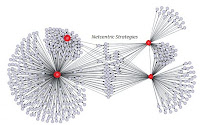SAP can be like a giant aircraft carrier moving powerfully across the ocean. It is huge and heavy and if you are a swimmer in the ocean trying to make it change directions to suite your purposes, good luck. A more successful approach is to understand the direction the ship is going and jump on board. Sign on, offer them a hand and help them get there. Perhaps as you gain their confidence they will let you into the wheelhouse where you can learn about their intended strategies and influence future directions.
Mobile software companies and their entrepreneurs often feel their mobile technology and strategy is better than all others. They often feel driven by a messianic mission to carry their mobile technology message to the world, and then scream in frustration when others don't seem to "get it." I understand. I have screamed.
Mobility entrepreneurs are often focused on their specific mobile technology. Many have engineering backgrounds and believe they have solved a significant problem. The challenge they often face is not understanding the business of their potential partners, resellers and target customers. Let me provide the following scenario to demonstrate my point:
There is a large conference room with a long table. There are 2 mobility entrepreneurs, 12 IT managers for a large SAP customer, 4 sales and pre-sales folks from SAP, and 3 representatives from a large system integrator with a focused SAP practice in attendance. The mobility entrepreneurs stand up and present the "world's best" enterprise mobility technology to the attendees. When they are done presenting, lots of questions are asked; the entrepreneurs cover them all and leave to catch their flight home expecting a PO on the fax machine when they arrive. The PO never arrives. Why?
Here are some possible reasons:
- The SAP customer has a $14 million problem, and the mobile technology presented will solve only $675,000 of that problem. They need a complete solution, not a partial.
- The $14 million problem requires a full range of systems integration, business process design and SAP customization to fix. They want to fix this problem with one overall integrated solution, not many small solutions linked together. Complexity can kill.
- The SAP customer has three preferred SAP systems integrators – none have a practice around this particular mobile technology.
- The SAP customer is simplifying their IT infrastructure to reduce complexity and no non-SAP technology will be added unless it is approved by 17 business and IT committees. Who has the time to fight this battle?
- The IT Managers only want to learn mobile technology that will add to their resume and help them get their next assignment. The cool mobile technology that they just witnessed does not have its own category on the IT recruiters' websites. They want NAME power on their resume.
- The SAP system integrator does not support the mobile technology, so recommends some other mobile solution that they support and have trained experts on.
- The SAP sales team does not get quota credit on it, but they do on another mobile solution. If the sales person does not make their numbers they are fired, so they do not care which mobile technology is better if it does not help keep their job.
- SAP's Industry Principals and Solutions Managers also must be very selective as to the mobile technology they recommend. They would not want to recommend a product that was not on the SAP price list or Certified Partner list, unless there was no other viable choice or this product helped sell other SAP licenses that benefited the SAP sales team. Their priorities would be:
- SAP solution
- SAP price list solution (could be a partner's solution on the price list)
- SAP Certified or Innovation Partner
- Only in desperate times would a non-partner be recommended and then only if it helped sell more SAP products
- SAP pre-sales teams learn about many different technologies, but if it does not help their Account Executive make his/her quarterly numbers, it is unlikely to be introduced to the customer. However, there is an exception; if the solution, combined with an SAP solution helps close more revenue for the SAP Account Executive, then you have a winner.
- SAP customers are often on 5 year plans. These plans include upgrades, roll-outs, add-ons, customization, old product sun setting, mergers and acquisitions, etc. What does this mean to the mobile entrepreneur? It means your product needs a 5 year road map that aligns with SAP and the SAP customer's. If it does not, you are unlikely to survive the first round.
- Large software companies like SAP often consider potential partners as possible acquisition targets. Issues like are you private or public, customer base size, intellectual property ownership, market presence, etc, play into these considerations. If two partners have similar technologies, the one that is a better future acquisition target may be chosen for strategic reasons.
- The SAP customer may have outsourced their IT to a large service provider with their own recommended mobile solution.
- The SAP customer may have a large server deal with IBM, and IBM agrees to throw in a software solution for free if the annual support contracts are renewed...it happened to me :-(
- The biggest project and highest priority in the company is around route delivery improvement, and your project is mobile SAP CRM. The route delivery mobility vendor agrees to extend their mobile solution into mobile CRM and since it is a higher priority, you lose.
- The CIO will never get invited to speak in front of thousands at Sapphire if they choose your solution.
- Your user conferences could be held at Denny's.
In summary, a mobile solution needs to be viewed favorably by the SAP customer, SAP sales team and the SAP system integrator. Not always all of them, but most of them. It needs to align with most of their strategic visions, personal interests and compensation structures. The frustrating part of this list for many mobility entrepreneurs is that none of it has to do with "best" mobile technology. These are primarily business issues that relate to alliances, partnerships, self-interests, marketing, strategic directions and business models.
Since we live in the real world, not all of the players' motivations will be clear or have the same level of priority. Sometimes new technologies appear that do not fit these molds, but once you understand these underlying motivations it becomes more clear.
If you are interested in discussing these issues in more detail and/or learning more about my consulting practice please contact me.
Watch for Part 5 in this series - it gives hope back to the Mobile Start-Ups. You can follow-me on Twitter (see right sidebar) and by RSS.
Related Articles:
- Advice for Mobile Start-ups: Working with SAP, Part 1
- Advice for Mobile Start-Ups: Working with SAP, Part 2
- Advice for Mobile Start-Ups: Working with SAP, Part 3
- Advice for Mobile Start-ups: Working with SAP, Part 5
- Advice for Mobile Start-Ups: Find Your Market Aggregation Points
- Advice to Mobile Start-Ups: You are a Publishing Company Like it or Not!
- Advice to Mobile Start-ups: Focus on Mobile Content, Mobile Business Processes, Integration and Workflow
***************************************************
Author Kevin Benedict
Mobility Consultant, Wireless Industry Analyst and Web 2.0 Marketing Expert
http://www.netcentric-strategies.com/
***Full Disclosure: I am an independent mobility consultant and Web 2.0 marketing expert and as such I work with, and have worked with, many of the companies mentioned in my articles.
**************************************************








